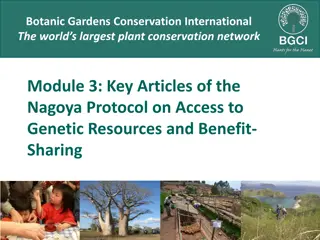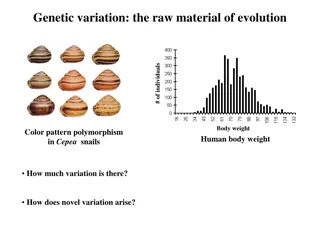Evolution of Plant Improvement: Domestication to Genetic Modification
Plant improvement has evolved through different eras - from ancient domestication to the Green Revolution and genetic modification. Domestication shaped major crops over millennia, the Green Revolution introduced high-yielding varieties, and genetic modification allows direct genetic alterations for desired traits since the 1980s.
Download Presentation

Please find below an Image/Link to download the presentation.
The content on the website is provided AS IS for your information and personal use only. It may not be sold, licensed, or shared on other websites without obtaining consent from the author. Download presentation by click this link. If you encounter any issues during the download, it is possible that the publisher has removed the file from their server.
E N D
Presentation Transcript
Eras of Plant Improvement Domestication The Green Revolution Genetic Modification
Continuous Improvements in Agriculture The distant past (thousands of years ago) Crop plant domestication The recent past (past 100 years) Hybrid seeds/intentional breeding The "Green Revolution" Now and into the future (past 25 years) Advances in breeding Genetic modification technologies
Phase 1: Domestication More than 10,000 years ago until approximately 1900 Humans transitioned from hunter-gatherer lifestyle with improvements in agriculture Development of human civilizations is correlated with the development of agriculture Major crops were domesticated approximately 5,000 15,000 years ago Domestication: cultivating or taming organisms to accentuate traits that are considered desirable for humans Physical appearance Behavioral characteristic Individual size Selecting for physical traits modified the genetic makeup of the plant
Phase 2: The Green Revolution 1960s - 1980s Important advancements: High-yielding grain varieties (rice, wheat) "semi-dwarf" varieties: shorter plants that waste less energy on growing stems for height Disease-resistance Dramatically increased crop yields for the same acreage of land Able to grow more food without using more land
Phase 3: Genetic Modification 1980s present Advances in science and genetic understanding have led to technologies that allow scientists to directly modify the genetic make up of species to exhibit a trait of interest Can use genes from that species or another First crops released in 1995 Herbicide and insect resistant reduces pesticide needs, increases yield Rapidly adopted by farmers increased farmer profits Primary crops: cotton, soybean, corn, canola, cotton, alfalfa, papaya Lots of possibilities for potential improvements (GMOs)























